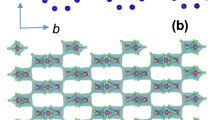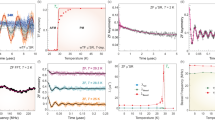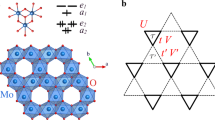Abstract
The emergence of complex electronic behaviour from simple ingredients has resulted in the discovery of numerous states of matter. Many examples are found in systems exhibiting geometric magnetic frustration, which prevents simultaneous satisfaction of all magnetic interactions. This frustration gives rise to complex magnetic properties such as chiral spin structures1,2,3, orbitally driven magnetism4, spin-ice behaviour5 exhibiting Dirac strings with magnetic monopoles6, valence-bond solids7,8 and spin liquids9,10. Here we report the synthesis and characterization of LiZn2Mo3O8, a geometrically frustrated antiferromagnet in which the magnetic moments are localized on small transition-metal clusters rather than individual ions11,12,13. By doing so, first-order Jahn–Teller instabilities and orbital ordering are prevented, allowing the strongly interacting magnetic clusters in LiZn2Mo3O8 to probably give rise to an exotic condensed valence-bond ground state reminiscent of the proposed resonating valence-bond state14,15. Our results also link magnetism on clusters to geometric magnetic frustration in extended solids, demonstrating a new approach for unparalleled chemical control and tunability in the search for collective, emergent electronic statesof matter16,17.
This is a preview of subscription content, access via your institution
Access options
Subscribe to this journal
Receive 12 print issues and online access
$259.00 per year
only $21.58 per issue
Buy this article
- Purchase on Springer Link
- Instant access to full article PDF
Prices may be subject to local taxes which are calculated during checkout


Similar content being viewed by others
References
Bode, M. et al. Chiral magnetic order at surfaces driven by inversion asymmetry. Nature 447, 190–193 (2007).
Grohol, D. et al. Spin chirality on a two-dimensional frustrated lattice. Nature Mater. 4, 323–328 (2005).
Taguci, Y., Oohara, Y., Yoshizawa, H., Nagaosa, N. & Tokura, Y. Spin chirality, Berry phase, and anomalous Hall effect in a frustrated ferromagnet. Science 291, 2573–2576 (2001).
Chen, G. & Balents, L. Spin–orbit coupling in d2 ordered double perovskites. Phys. Rev. B 84, 094420 (2011).
Fennell, T. et al. Magnetic coulomb phase in the spin ice Ho2Ti2O7 . Science 326, 415–417 (2009).
Morris, D. J. P. et al. Dirac strings and magnetic monopoles in the spin ice Dy2Ti2O7 . Science 326, 411–414 (2009).
Affleck, I., Kennedy, T., Lieb, E. H. & Tasaki, H. Rigorous results on valence bond ground states in antiferromagnets. Phys. Rev. Lett. 59, 799–802 (1987).
Matan, K. et al. Pinwheel valence-bond solid and triplet excitations in the two-dimensional deformed kagome lattice. Nature Phys. 6, 865–869 (2010).
Pratt, F. L. et al. Magnetic and non-magnetic phases of a quantum spin liquid. Nature 471, 612–616 (2011).
Anderson, P. W. The resonating valence bond state in La2CuO4 and superconductivity. Science 235, 1196–1198 (1987).
Bramwell, S. T. & Gingras, M. J. P. Spin ice state in frustrated magnetic pyrochlore materials. Science 294, 1495–1501 (2001).
Carlo, J. P. et al. Triplet and in-gap magnetic states in the ground state of the quantum frustrated fcc antiferromagnet Ba2YMoO6 . Phys. Rev. B 84, 100404 (2011).
Winterlink, J. et al. Exotic magnetism in the alkali sesquioxides Rb4O6 and Cs4O6 . Phys. Rev. B 79, 214410 (2009).
Anderson, P. W. Resonating valence bonds: A new kind of insulator? Mater. Res. Bull. 8, 153–160 (1973).
Anderson, P. W. On the ground state properties of the anisotropic triangular antiferromagnet. Phil. Mag. 30, 423–440 (1973).
McCarley, R. E. Inorganic Chemistry Toward the 21st Century Vol. 211,273–290 (American Chemical Society, 1983).
King, R. B. Encyclopedia of Inorganic Chemistry Vol. 2 (Wiley, 1994).
Nakatsuji, S. et al. Spin disorder on a triangular lattice. Science 309, 1697–1700 (2005).
Yamashita, S., Yamamoto, T., Nakazawa, Y., Tamura, M. & Kato, R. Gapless spin liquid of an organic triangular compound evidenced by thermodynamic measurements. Nature Commun. 2, 1–6 (2011).
Shores, M. P., Nytko, E. A., Bartlett, B. M. & Nocera, D. G. A structurally perfect S=1/2 Kagome antiferromagnet. J. Am. Chem. Soc. 127, 13462–13463 (2005).
Helton, J. S. et al. Spin dynamics of the spin-1/2 Kagome lattice antiferromagnet ZnCu3(OH)6Cl2 . Phys. Rev. Lett. 98, 107204 (2007).
Okamoto, Y., Nohara, M., Aruga-Katori, H. & Takagi, H. Spin liquid state in the S=1/2 hyperkagome antiferromagnet Na4Ir3O8 . Phys. Rev. Lett. 99, 137207 (2007).
Castelnovo, C., Moessner, R. & Sondhi, S. L. Magnetic monopoles in spin ice. Nature 451, 42–45 (2008).
Benbow, E. M., Dalal, N. S. & Latturner, S. E. Spin glass behavior of isolated, geometrically frustrated tetrahedra of iron atoms in the intermetallic La21Fe8Sn7C12 . J. Am. Chem. Soc. 131, 3349–3354 (2009).
De La Cruz, C. et al. Magnetic order close to superconductivity in the iron based layered LaO1−xFxFeAs systems. Nature 453, 899–902 (2008).
Pene, K., Shannon, N. & Shiba, H. Half-magnetization plateau stabilized by structural distortion in the antiferromagnetic Heisenberg model on a pyrochlore lattice. Phys. Rev. Lett. 93, 197203 (2004).
Freedman, D. E. et al. Site specific X-ray anomalous dispersion of the geometrically frustrated Kagome magnet, herbertsmithite, ZnCu3(OH)6Cl2 . J. Am. Chem. Soc. 132, 16185–16190 (2010).
Wang, R. F. et al. Artificial ‘spin ice’ in a geometrically frustrated lattice of nanoscale ferromagnetic islands. Nature 439, 303–306 (2006).
Torardi, C. C. & McCarley, R. E. Synthesis, crystal structures, and properties of LiZn2Mo3O8, Zn3Mo3O8, and ScZnMo3O8, reduced derivatives containing the Mo3O13 cluster unit. Inorg. Chem. 24, 476–481 (1985).
Bridges, C. A., Hansen, T., Wills, A. S., Luke, G. M. & Greedan, J. E. Frustrated magnetism and the effects of titanium substitution in the mixed valence oxide BaV10−xTix015 . Phys. Rev. B 74, 024426 (2006).
Larson, A. C. & Von Dreele, R. B. General Structure Analysis System (GSAS), Los Alamos National Laboratory Report LAUR, 86–748 (1994).
Toby, B. H. EXPGUI, a graphical user interface for GSAS. J. Appl. Cryst. 34, 210–213 (2001).
Schmidt, M. W. et al. General atomic and molecular electronic structure system. J. Comput. Chem. 14, 1347–1363 (1993).
Acknowledgements
This research is supported by the US Department of Energy, Office of Basic Energy Sciences, Division of Materials Sciences and Engineering under Award DE-FG02-08ER46544. Use of the Spallation Neutron Source was supported by the Division of Scientific User Facilities, Office of Basic Energy Sciences, US Department of Energy, under contract DE-AC05-00OR22725 with UT-Battelle, LLC. J.P.S. acknowledges the assistance of J. Hodges in collecting and analysing powder neutron data from POWGEN/SNS. T.M.M. acknowledges useful discussions with O. Tchernyshyov and C. Broholm.
Author information
Authors and Affiliations
Contributions
T.M.M. supervised the project. J.P.S. and D.G.S. prepared samples. J.P.S. measured neutron diffraction patterns. J.P.S. and T.M.M. measured properties, and J.P.S., J.R.N. and T.M.M. analysed data and prepared the manuscript.
Corresponding author
Ethics declarations
Competing interests
The authors declare no competing financial interests.
Supplementary information
Supplementary Information
Supplementary Information (PDF 1723 kb)
Rights and permissions
About this article
Cite this article
Sheckelton, J., Neilson, J., Soltan, D. et al. Possible valence-bond condensation in the frustrated cluster magnet LiZn2Mo3O8. Nature Mater 11, 493–496 (2012). https://doi.org/10.1038/nmat3329
Received:
Accepted:
Published:
Issue Date:
DOI: https://doi.org/10.1038/nmat3329
This article is cited by
-
Multiflavor Mott insulators in quantum materials and ultracold atoms
npj Quantum Materials (2024)
-
Signatures of a Majorana-Fermi surface in the Kitaev magnet Ag3LiIr2O6
Communications Physics (2023)
-
CrRhAs: a member of a large family of metallic kagome antiferromagnets
npj Quantum Materials (2023)
-
Correlated flat bands and quantum spin liquid state in a cluster Mott insulator
Communications Physics (2023)
-
Pressure-driven symmetry breaking and electron disproportionation of the trigonal Nb3 cluster in Nb3Cl8
Science China Physics, Mechanics & Astronomy (2022)



